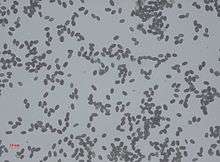Stachybotrys
Stachybotrys (/ˌstækiˈbɒtrɪs/) is a genus of molds, hyphomycetes or asexually reproducing, filamentous fungi, now placed in the family Stachybotryaceae. Historically, it was considered closely related to the genus Memnoniella,[1][2] because the spores are produced in slimy heads rather than in dry chains. Recently, the synonymy of the two genera is generally accepted.[3] Most Stachybotrys species inhabit materials rich in cellulose. The genus has a widespread distribution and contains about 50 species.[4] The name comes from the Greek words σταχυς stakhus (ear of grain, stalk, stick; metaphorically, progeny) and βότρυς botrus (cluster or bunch as in grapes, trusses).
| Stachybotrys | |
|---|---|
| Scientific classification | |
| Kingdom: | Fungi |
| Division: | Ascomycota |
| Class: | Sordariomycetes |
| Order: | Hypocreales |
| Family: | Stachybotryaceae |
| Genus: | Stachybotrys Corda, 1837 |
| Species | |
|
~ 50, see text | |
The most infamous species, S. chartarum (previously known as S. atra) and S. chlorohalonata, are known as "black mold" or toxic black mold in the U.S., and are frequently associated with poor indoor air quality that arises after fungal growth on water-damaged building materials.[5] Stachybotrys chemotypes are toxic, with one producing trichothecene mycotoxins including satratoxins, and another that produces atranones.[6]
Detection
Four distinctive microbial volatile organic compounds (MVOCs) – 1-butanol, 3-methyl-1-butanol, 3-methyl-2-butanol, and thujopsene – were detected on rice cultures, and only one (1-butanol) was detected on gypsum board cultures.[7]
Removal
Contact a licensed indoor environmental assessor, and provide a lab analysis and hire a certified mold remediator.
Pathogenicity

Symptoms of Stachybotrys exposure in humans
A controversy began in the early 1990s after analysis of two infant deaths and multiple cases in children from the poor areas of Cleveland, Ohio, due to pulmonary hemorrhage were initially linked to exposure to heavy amounts of Stachybotrys chartarum. Subsequent and extensive reanalysis of the cases by the United States Centers for Disease Control and Prevention have failed to find any link between the deaths and the mold exposure.[8][9]
Species
- Stachybotrys albipes (Berk. & Broome) S.C. Jong & Davis (1976)
- Stachybotrys alternans Bonord. (1851)
- Stachybotrys breviuscula McKenzie (1991)
- Stachybotrys chartarum (Ehrenb.) S. Hughes (1958)
- Stachybotrys chlorohalonata B. Andersen & Thrane (2003)
- Stachybotrys cylindrospora C.N. Jensen (1912)
- Stachybotrys dichroa Grove (1886)
- Stachybotrys elegans (Pidopl.) W. Gams (1980)
- Stachybotrys eucylindrospora D.W. Li (2007)
- Stachybotrys freycinetiae McKenzie (1991)
- Stachybotrys kampalensis Hansf. (1943)
- Stachybotrys kapiti Whitton, McKenzie & K.D. Hyde (2001)
- Stachybotrys longispora Matsush. (1975)
- Stachybotrys mangiferae P.C. Misra & S.K. Srivast. (1982)
- Stachybotrys microspora (B.L. Mathur & Sankhla) S.C. Jong & E.E. Davis (1976)
- Stachybotrys nephrodes McKenzie (1991)
- Stachybotrys nephrospora Hansf. (1943)
- Stachybotrys nilagirica Subram. (1957)
- Stachybotrys oenanthes M.B. Ellis (1971)
- Stachybotrys parvispora S. Hughes (1952)
- Stachybotrys ruwenzoriensis Matsush. (1985)
- Stachybotrys sansevieriae G.P. Agarwal & N.D. Sharma (1974)
- Stachybotrys sinuatophora Matsush. (1971)
- Stachybotrys suthepensis Photita, P. Lumyong, K.D. Hyde & McKenzie (2003)
- Stachybotrys theobromae Hansf. (1943)
- Stachybotrys waitakere Whitton, McKenzie & K.D. Hyde (2001)
See also
- Bioaerosol
- Mold growth, assessment, and remediation
- Mold health issues
- Sick building syndrome
References
- Haugland, Richard A.; Vesper, Stephen J.; Harmon, Stephen M. (January–February 2001). "Phylogenetic relationships of Memnoniella and Stachybotrys species and evaluation of morphological features for Memnoniella species identification" (PDF). Mycologia. 93 (1): 54–65. doi:10.2307/3761605. JSTOR 3761605. Archived (PDF) from the original on July 19, 2018 – via Zenodo.
- Castlebury, Lisa A.; Rossman, Amy Y.; Sung, Gi-Ho; Hyten, Aimee S.; Spatafora, Joseph W. (August 2004). "Multigene phylogeny reveals new lineage for Stachybotrys chartarum, the indoor air fungus" (PDF). Mycological Research. 108 (8): 864–72. doi:10.1017/S0953756204000607. PMID 15449591. Archived (PDF) from the original on November 3, 2019.
- Seifert, Keith A.; Gams, Gareth; Morgan-Jones, Walter; Kendrick, Bryce (2011). The Genera of Hyphomycetes. CBS Biodiversity Series. Utrecht, the Netherlands: CBS Fungal Biodiversity Centre. pp. 1–997. ISBN 978-90-70351-85-4. ISSN 1571-8859.
- Paul M., Kirk; Cannon, Paul F.; Minter, David W.; Stalpers, Joost A., eds. (2008). Dictionary of the Fungi (10th ed.). Wallingford: CABI. p. 659. ISBN 978-0-85199-826-8. LCCN 2009285939.
- Nielsen, Kristian Fog (July 2003). "Mycotoxin production by indoor molds" (PDF). Fungal Genetics and Biology. 39 (2): 103–17. doi:10.1016/S1087-1845(03)00026-4. PMID 12781669. Archived (PDF) from the original on April 10, 2017.
- Andersen, Birgitte; Nielsen, Kristian F.; Thrane, Ulf; Szaro, Tim; Taylor, John W.; Jarvis, Bruce B. (2003). "Molecular and phenotypic descriptions of Stachybotrys chlorohalonata sp. nov. and two chemotypes of Stachybotrys chartarum found in water-damaged buildings" (PDF). Mycologia. 95 (6): 1227–38. doi:10.1080/15572536.2004.11833031. PMID 21149024. Archived (PDF) from the original on September 17, 2018 – via the University of California Berkeley.
- Gao, Pengfei; Martin, Jennifer (June 2002). "Volatile metabolites produced by three strains of Stachybotrys chartarum cultivated on rice and gypsum board". Applied Occupational and Environmental Hygiene. 17 (6): 430–6. doi:10.1080/10473220290035462. PMID 12049433. NIOSHTIC No. 20022270.
- "Case Definition for Acute Idiopathic Pulmonary Hemorrhage in Infants". National Center for Environmental Health. Archived from the original on November 15, 2001.
- Centers for Disease Control and Prevention (March 10, 2000). "Update: Pulmonary Hemorrhage/Hemosiderosis Among Infants — Cleveland, Ohio, 1993–1996". Morbidity and Mortality Weekly Report. 49 (09): 180–4. Archived from the original on May 20, 2016.
Further reading
- Progovitz, Richard F. (2003). Black Mold: Your Health and Your Home. The Forager Press. ISBN 978-0-9743943-9-8.
External links
| Wikimedia Commons has media related to Stachybotrys. |
- "Facts about Stachybotrys chartarum and Other Molds". Centers for Disease Control and Prevention. Archived from the original on November 1, 2019.